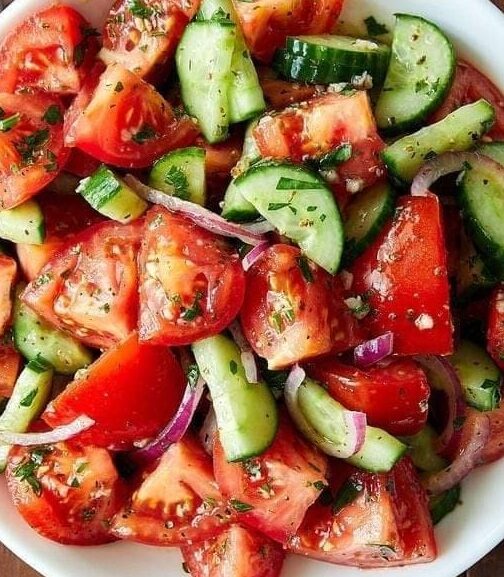Seeking a lively and flavorful boost for your meals? Try pickled cherry tomatoes, red onions, and cucumbers! This simple recipe enhances your dishes with a refreshing crunch and a tangy kick that will tantalize your taste buds. Discover how to create this delightful pickle!
Table of Contents
- Introduction to Pickling
- Ingredients You’ll Need
- 2.1 Fresh Produce
- 2.2 Pickling Liquid
- 2.3 Optional Spices
- Step-by-Step Preparation
- 3.1 Preparing the Vegetables
- 3.2 Making the Pickling Brine
- 3.3 Packing the Jars
- Storage Tips
- Serving Suggestions
- Health Benefits of Pickling
- Common Mistakes to Avoid
- Variations of the Recipe
- Final Thoughts
- FAQs
1. Introduction to Pickling
Pickling is an age-old preservation method that enhances the flavor of fruits and vegetables while extending their shelf life. The process involves soaking produce in a vinegar-based solution, resulting in a tangy and crunchy treat that’s perfect for snacking or as a side dish.
2. Ingredients You’ll Need
2.1 Fresh Produce
- Cherry tomatoes: Choose ripe and firm ones for the best flavor.
- Red onions: Their sweetness pairs beautifully with the tangy brine.
- Cucumbers: Small, crisp varieties work best, like Persian or Kirby cucumbers.
2.2 Pickling Liquid
- Vinegar: White vinegar or apple cider vinegar is ideal for pickling.
- Water: To dilute the vinegar for a balanced flavor.
- Sugar: Adds a hint of sweetness to counter the acidity.
- Salt: Essential for flavor and preserving.
2.3 Optional Spices
- Garlic: For an extra kick of flavor.
- Dill: Fresh or dried dill adds a delightful herbal note.
- Peppercorns: A few whole peppercorns can spice things up!
3. Step-by-Step Preparation
3.1 Preparing the Vegetables
Start by washing your cherry tomatoes, cucumbers, and red onions. Slice the cucumbers into thin rounds, and slice the red onions into rings. For the tomatoes, you can leave them whole or halve them if you prefer smaller bites.
3.2 Making the Pickling Brine
In a saucepan, combine equal parts vinegar and water (about 1 cup each), then add sugar and salt to taste (about 1-2 tablespoons of each). Heat over medium heat, stirring until the sugar and salt dissolve. You can also add your optional spices at this stage to infuse more flavor.
3.3 Packing the Jars
Place the prepared vegetables in clean, sterilized jars. Pour the hot pickling brine over the veggies, ensuring they are fully submerged. Let the jars cool to room temperature before sealing.
4. Storage Tips
Store your pickled veggies in the refrigerator. They’ll be ready to enjoy after a few hours, but for the best flavor, let them sit for at least 24 hours. They can last up to two weeks in the fridge.
5. Serving Suggestions
These pickled delights are versatile! Serve them as a refreshing side dish, atop sandwiches, or as a vibrant addition to salads. They also make a great topping for tacos or grilled meats!
6. Health Benefits of Pickling
Pickled vegetables retain many of their original nutrients and add probiotics, which are beneficial for gut health. Plus, they’re low in calories and can enhance the flavor of your meals without adding excessive fat or calories.
7. Common Mistakes to Avoid
- Skipping sterilization: Always use sterilized jars to prevent spoilage.
- Not using enough salt: Salt is crucial for flavor and preservation.
- Overcrowding jars: Give the vegetables space to absorb the brine evenly.
8. Variations of the Recipe
- Spicy Pickles: Add red pepper flakes or sliced jalapeños for heat.
- Herbed Variations: Experiment with other herbs like thyme or basil for unique flavors.
9. Final Thoughts
Pickling cherry tomatoes, red onions, and cucumbers is an easy way to add a burst of flavor to your meals. With just a few simple ingredients and steps, you can create a delicious side that complements a variety of dishes.
10. FAQs
Q1: How long do pickled vegetables last?
In the fridge, they can last up to two weeks.
Q2: Can I use different types of vinegar?
Absolutely! Apple cider vinegar and rice vinegar are great alternatives.
Q3: Do I need to heat the brine?
Heating helps dissolve the sugar and salt, but you can skip it if you’re short on time.
Q4: Can I pickle other vegetables?
Yes! Carrots, radishes, and bell peppers also work well.
Q5: Are pickled vegetables healthy?
Yes, they provide probiotics and are low in calories while retaining nutrients.

